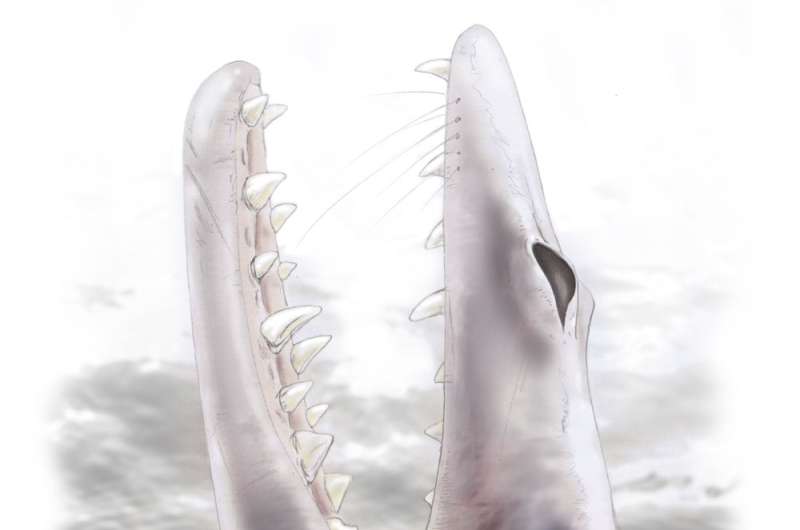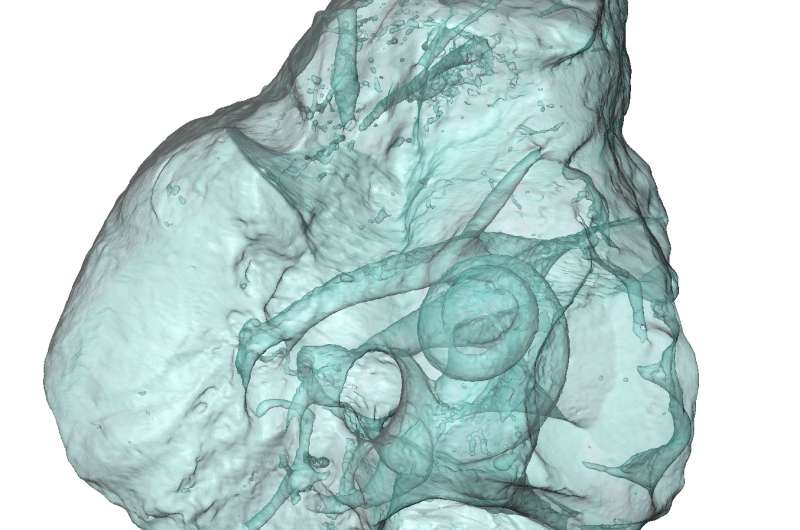Extinct early whales listened like their relatives on land, fossil evidence shows

Whales rely on a keen sense of hearing for their underwater existence. But whales show surprisingly vast differences in hearing ability. Baleen whales tune into infrasonic sounds—at frequencies too low for humans to hear—to communicate over long distances. Toothed whales do just the opposite, relying on ultrasonic frequencies too high for humans to hear.
Now researchers reporting in Current Biology on June 8 have fossil evidence from extinct early whale species to suggest that those differences in hearing arose only after whales evolved into the fully aquatic animals we know today. That's based on their findings that whales known as protocetes, which spent time both in water and on land, appear to have hearing more like their terrestrial, even-toed ungulate relatives, including pigs, hippos, and camels.
"We found that the cochlea of protocetes was distinct from that of extant whales and dolphins and that they had hearing capacities close to those of their terrestrial relatives," says Maeva Orliac of CNRS and Université de Montpellier in France.
Protocetes' lack of hearing specialization suggests that the early whales were unable to echolocate and communicate through long-distance calls in the way that modern-day cetaceans, the group including whales and dolphins, do.
The researchers came to those conclusions based on studies of 45-million-year-old protocetid whale remains found in marine deposits from Togo in West Africa. The researchers studied the bony labyrinth, a hollow cavity that would have housed the hearing organ, in two species of early whales.

Orliac and her colleague Mickaël Mourlam used micro-CT scanning to peer inside the internal structures of rocks and fossils, in much the same way that an X-ray scanner makes it possible to see bones inside a person's body. Those images allowed them to analyze the internal cavities of the petrosal bone, which shelters the organs of hearing and balance.
"Based on the scans provided by the scanner, we could extract a virtual mold of the hollow cavity that used to contain the hearing organ when the animal was alive," Orliac says. "This process was long and difficult because this cavity was filled with sediments and partly recrystallized and because the petrosal bone in cetaceans is particularly thick and dense, which lowers the quality of the images and sometimes impedes analyzing them."
Nevertheless, the scans suggest that early cetaceans had hearing closer to that of their terrestrial relatives. Specialization to infrasonic or ultrasonic hearing as seen in modern whales came only later, in whales that had already found their way back to the sea.
The findings highlight the importance of studying these early cetaceans to get an accurate picture of whales' evolutionary history. It also suggests that whales' evolutionary past is more complicated than had previously been described, the researchers say.
Orliac says they'll be back in field in Togo in December to search for additional protocetid whale specimens. They've so far described two of three species identified in Togo based on dental remains. They hope to find a specimen that will allow them to explore the ear of the third.
More information: Current Biology, Mourlam and Orliac: "Infrasonic and Ultrasonic Hearing Evolved after the Emergence of Modern Whales" www.cell.com/current-biology/f … 0960-9822(17)30506-7 , DOI: 10.1016/j.cub.2017.04.061
Journal information: Current Biology
Provided by Cell Press





















